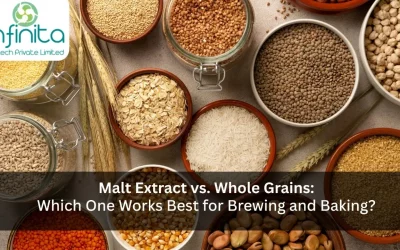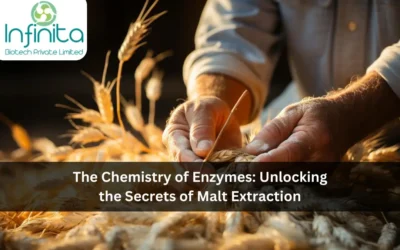Malting is a process through which different grains, especially barley, are prepared for brewing through a controlled germination process in a humid environment. Many other grains can be used for malting which can include sorghum, wheat, oats, rye, corn among others. Barley is the preferred one as it has a high starch to protein ratio. It also has a clinging husk that produces more yield, better quality and more flavoured beverages like beers.
What is the Malting Process in the Brewing Industry?
The malting process in the brewing industry consists of the following 4 steps.
1. Steeping
The first step is the steeping process. It is done to raise the moisture in the grain from nearly 12 per cent to around 45 per cent. The steeping process entails immersing the grain in water and then draining and airing it at regular intervals of about 8 hours each. The whole process takes about 2 to 3 days. Steeping is done to speed up the malting process in the brewing industry. It activates the enzymes that are naturally present in the grain. These enzymes sped up the process of complex molecules like proteins and carbohydrates that are present within the kernel. This process also activates the growth hormones in the grain. The grain starts to germinate and its “chits” or tiny roots start growing.
2. Germination
Germination is the next phase of the malting process, also known as the control phase. The steeped grain is then transferred to the germination room. The grain is kept between 16°C and 19°C for another 4 to 6 days. The grain is kept well aerated through a flow of humid air and is turned frequently. This avoids the roots growing from matting together. It also clears the carbon dioxide, heat and moisture generated during the process. The germination process is also carried out to speed up the malting process in the brewing industry as the grain enzymes become more active. The resultant activity yields soluble starch, malt sugars and amino acids from usable yeast nutrients.
3. Kilning
The next step in the malting process is kilning. Here the grains are dried at the temperature of 80°C to 90°C for about 2 to 4 hours. The grains get dried down to 3-5% moisture. This process preserves nutrients in the grain by eliminating the embryo. Enzymes continue to work initially in this process but as the temperature rises the enzymes become dormant. The enzymes can again be reactivated later by the hot and humid environment in the mashing vessel.
Different coloured and flavoured malts are produced by variations in air flows and kiln temperature. Small rootlets are removed from the resultant malt and the latter is taken for roasting.
4. Roasting
This is the last step of the malting process in the brewing industry. It takes place in the 2 roasting drums for a period of 2 to 3 hours at very high temperatures. A batch of malt may weigh between 2.4 to 3.4 tons. The roasted malt is then placed in a cooler for about 35 to 60 minutes to cool it down. It also fixes the colour and flavours. Further, the malt is examined, stored and dispatched.
Enzymes In the Brewing Industry
Due to low-quality malt and the use of adjuncts in the brewing process, extraneous enzymes are required in the brewery industry. Enzymes speed up the malting process in the brewing industry and also save energy. Enzymes found in grains include protease, xylanase, alpha and beta-amylase and pullulanase. To speed up the malting process, enhance the flavour, colour and texture of beverages the ahead mentioned enzymes are commonly used. These are alpha-amylase, beta-amylase, beta-glucanase, and protease. Let’s have a look at their functioning below.
1. Amylases
Amylases are used for breaking down starch in the malting process. Amylase breakdown starch into smaller molecules of glucose, maltose, and oligosaccharides. Amylase requires a controlled temperature to function. Alpha-amylase requires an optimal pH and temperature of 5.2 and 73.89°C to function. On the other hand, beta-amylase require an optimal pH and temperature of 5.5 and 62.78°C. Beta amylases are essential for the saccharification process & maltose production and are used commercially in the brewing industry.
2. Beta-Glucanase
Beta Glucanase is an essential enzyme required for the malting process in the brewing industry, especially in the malting and mashing process.
Beta Glucanase hydrolyses B-glucan polymers to release extra sugars and control viscosity. Beta Glucanase is naturally found in barley and is also known as endo-b1, 3-1, 4-glucanases. For manufacturing lighter beers, commercial-grade Beta-Glucanase is used as it clears the beer colour. Between 300 grams to 1 kg of this enzyme is used for a ton of malt. Beta Glucanase works at the optimum temperature of 45°C to hydrolyze the cell walls of the grains.
3. Protease
Protease breaks down peptide bonds in proteins. Protease use enhances the beer quality by improving protein solubility that lowers beer viscosity and enhances the flavour. Protease speeds up the yeast growth, mashing process and wort fermenting. Protease occurs naturally in grain kernels, with commercial-grade protease added judicially to the malting process to enhance the beer quality.
4. Other Enzymes Used in Malting Process in Brewing Industry
Other enzymes are increasingly being used to achieve higher brewing quality. These enzymes maintain and enhance the beer quality and are also used for preserving the beers for a long period. Alpha-acetolactate decarboxylase (ALDC), is an enzyme that reduces the foul smell of diacetyl which is formed during the fermentation phase of beer production. Ficin and papain are chill proof thermostability enzymes that hydrolyze proteins and thus help with the chilling haze.
Conclusion
What is the malting process in the brewing industry? Hope our article answers all your queries regarding this topic. Enzymes are necessary for the malting and brewing industry. Enzymes are biological catalysts that speed up the malting process and enhance the quality of malt beverages. Enzymes have become essential today for different industries like detergents, fabric dying, pulp and paper and especially for the food & beverage industry.







